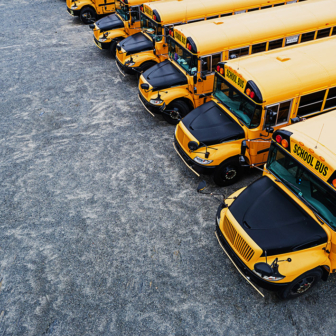Dean Ashenden has been writing for Inside Story about schools (among other things) for a decade, and he’s now distilled and developed his analysis in a new book, Unbeaching the Whale: Can Australia’s Schooling be Reformed? Here, he introduces the book’s themes; below, Inside Story readers can download a free PDF of the full text.
The historian Manning Clark believed that Australian political leaders fell into one of two groups; they were either “straighteners” and prohibitors or they were enlargers of life. So too ways of thinking about schools; my new book, Unbeaching the Whale, is an argument for an enlarging spirit in schooling and against the demand for compliance before all else.
That is not what I had in mind; the initial idea was to pull together some threads of thinking developed over a decade or so. Certainly I began with a set against what governments of all persuasions had been saying and doing about schools since the Howard years, an approach driven with utter conviction by the Rudd/Gillard governments in their “education revolution” (with the sole but compelling exception of Gonski). But as I dug out and for the first time really focused on a mass of evidence about how things had been going, I got more than I’d bargained for.
I was not shocked, exactly, but taken aback by the consistency of the picture over a wide field and across many years: Australian schooling has been on the slide for two decades, is still on the slide and is showing no signs of turning around.
That conclusion was reinforced and expanded in scope late in the piece when I realised at last that much-publicised difficulties of a behavioural and emotional kind (“classroom disruption,” “school refusal,” early leaving, bullying, lack of “engagement,” problems of “wellbeing”) are even more marked, fundamental and significant than the cognitive shortcomings on which much of the evidence dwells. They suggest that schooling isn’t working, and that it isn’t working because what children and young people experience there is badly out of kilter with what they experience elsewhere.
There was more to come as I turned to the obvious question: why? Why didn’t an agenda prosecuted with exceptional vigour by exceptionally capable political leaders deliver what it promised, let alone do what really needed doing? There is nothing inherently wrong in the big arguments used to make schools sit up straight and do as they were told — choice, equality, “effective” teaching, and the duty owed by publicly funded schools to the wider society, including its economy. All can be constructive, inspiring even. But not the versions that came to dominate official minds.
Then came the third and final occasion for a sinking feeling: how and by whom could the slide be arrested and reversed? As the straightening agenda expanded and grew in confidence, the system of governance — already limited to doing what could be done in bits and pieces within three-year election cycles — became more complex and less capable. When the Productivity Commission looked at the problem it found that key elements of the national reform agenda had been “stalled” for thirteen years, and that the things talked about at national HQ could seem “remote” from the “lived experience” of teachers and school leaders. There is now no entity, national or other, no government, state/territory or federal, and no stakeholder or combination of stakeholders with a span of responsibility and authority and a relationship between brain and body close enough to conceive and drive change of the kind and scale required.
There is another side to this ledger, however. I was not the only or first to be dismayed at how things were playing out. Prominent veterans Brian Caldwell and Alan Reid (both former deans of education) conclude that “Australian schools have hit the wall” (Caldwell) and need “a major overhaul” (Reid). A former NSW education minister, Verity Firth, argues that the time has come for structural reform rather than more of the same. Her Western Australian counterpart (and former premier and Gonski panel member) Carmen Lawrence rages against the long tail, rising segregation, pathetically narrow performance measures, the failure of new school planning, “deeply disturbing” inequities, and “huge” differences in resourcing and opportunity. Barry McGaw, former chief executive of ACER, the Australian Council for Educational Research, and former head of education at the OECD, famously careful in his pronouncements, says bluntly that quality is declining, inequity is high, and the system is “resistant to reform”; his successor at the ACER, Geoff Masters, says “deep reforms” are “urgently required.”
All this comes amid a flurry of books about the “tyranny of merit” or “threats to egalitarian schooling,” books assaulting policy “that is taking us backwards” or calling for “reimagining” or “revolution” or “transformation” or a “ground-up rethink” of what “learning systems” are needed to equip students for “societal challenges we can’t yet imagine.”
And it’s not just policy wonks and the kinds of people who write books. Others trying to find a way through the maze include some actually giving life to the idea often given lip service by the powers-that-be: that all young people will become “confident and creative individuals, successful lifelong learners and active and informed members of community.” Now, for the first time, breakthroughs in the rigorous assessment of learning and growth are making it possible for schools to keep doing some of the important things they have long done and to do important new things as well, and, what’s more, to do it for everyone: to provide twelve safe, happy and worthwhile years across the board.
So the nub of the answer to the question posed in the book’s subtitle — can schooling be reformed? — is yes, but it’s a very big ask, and schools can’t do it by themselves. It requires a reorganisation or “restructuring” of the system of governance; of the sector system, government, independent and Catholic; and above all of the daily work of students and teachers.
That in turn requires a very different way of thinking about schools and reform: more incremental reform, yes, but within a big, long-term strategy for structural change; equality in schooling rather than through it; more fraternity as well as more equality and liberty; more choice, but made more equally available; sectors, yes, but not organised so that two feed off the third; realising that schools, like students and teachers, need space and support to find their own way within a negotiated framework; accepting that schools can contribute to prosperity, but not by aiming at it; and the really big one, focusing not on teaching, effective or otherwise, but on the organisation of the production of learning and growth by its core workforce, the students.
Thinking needs to be more politically capable and inspiring as well as enlarging in spirit, able to stimulate and guide the kind of top-down-bottom-up popular movement briefly seen in the “I Give a Gonski” campaign (and on a very much larger scale in the distant but formative tumults of the 1960s and early 1970s).
The case for such a big and risky rests on necessity (current and piecemeal reforms can’t do what needs to be done) and the fact that it really matters, not in a life-and-death way but in a hard-to-pin-down, universal, lasting way. •
Unbeaching the Whale is published by Inside Story in association with the Centre for Strategic Education and the Melbourne Graduate School of Education.







